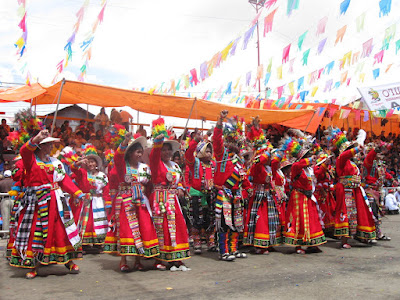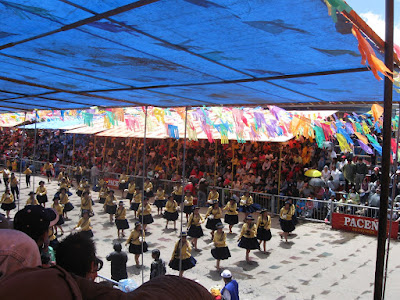



Weekend Carnival in Bolivia. A great experience not to be missed in all of Latin America and even in Europe or at home with the Quebec Winter Carnival, but only say that the flavor is quite different.


Long weekend: Saturday, Sunday and two days of holidays and the carnival in Oruro never stops, even at night. In reality, it begins the Thursday before the first weekend and ends 11 days following. During all these days, are held in sacred ceremonies and pagan. The main attraction of the Carnival of Oruro, the procession or pilgrimage, takes place the first Saturday morning until Sunday evening, and it continuously for more than 36 hours.


To read about this cultural event for me so far unprecedented, so it was intensely colorful, lively and uplifting, I am inspired by the "very" special publication of the scientific journal
La Patria in honor of the 2009 edition of the Carnival of Oruro.


diablada The dance of dances is one of the most traditional of all the Carnival of Oruro

Fraternities dancers are formed during the year indoors, among others, trade unions in various trades: to prepare a feast of friendship, loyalty and prosperity, an important tradition and belief still very much alive among workers in Bolivia.


Here they are my friends, the last row on the far right. Michael, my roommate, three girlfriends Quebec and a Dutchman. I hardly do myself sitting with them (not because I do not like them!), But I chose to squat on the floor at the bottom of bleachers all day to take pictures up close. And besides I do not like heights. But I will not say how much I suffered pulled muscles the next day. In addition to water-balloon that I found myself in the head!


We were all well dressed, with rain-proof water-balloon and the foam cylinder that everyone takes pleasure in throwing, because the Carnival is also the water war. The morning by going to the bleachers he had to run because they were all hidden on the roofs with buckets of water. The first Target: the gringos (foreigners) and even more obviously blond gringa!

Here they are, pitchers of water perched on top. Do you see them on the roof?

The Turkish toilet, which I'll spare you the smell (and for which you pay)! Decidedly, this is the case everywhere in Bolivia, and it seems even worse than it was before.

A saleswoman "focos" the water-balloon who are responsible for much of the festive atmosphere of Carnaval. It is a battle? Twelve to 40 under, okay? Or you choose a cylinder of foam for $ 3?

Meanwhile, the child is sleeping ....

Feeling hungry? Chicharon con mote? Pieces of pork with corn, but one that the North Americans give animals ... Farmers do not have money to buy the modified seeds. And you get used! Even without butter or salt!

No! They opted for a sandwich lomtito. That's what we looked like with our raincoats and our garlands in the neck! Michael, my roommate Australian and Lorraine, Quebec cooperative in Bolivia for two years.


The meaning of this holiday is primarily a celebration, a devotion to the Viergen de la Candelaria, Oruro known as the Virgen del Socavón. All dancers and musicians give themselves physically and morally as well as a tribute to the Virgin in a dance that refers, briefly, to the struggle of good against evil. Growth is deeply rooted in the culture of the peoples of the highlands of the Andes.


It is probably for these costumes filled with tradition and know-how, for these dances to traditional roots, the music transformed by time, since as far back as 1781, and all this devotion, this magic, the mysticism, that UNESCO gave the title to the Carnival of Oruro in Bolivia, "Masterpiece of Oral and Intangible Heritage of Humanity."

Los diablos that are subordinated to the power of Lucifer and Satan and who personify the seven deadly sins is sloth, pride, gluttony, lust, greed, anger and envy .


Las Virtudes devils dancing alongside representing the 7 deadly sins.


The pilgrimage starts outside the city and through the streets, which are installed on each side of the bleachers filled with people. Dancers and musicians parade to make an "entry" majestic (the most energetic dances, more intense music) to the "central plaza.
They then headed high in the city, on the side of a mountain that was once home to a large mine and on which we built the Cathedral del Socavón. The church overlooks both the city and its history mining.

the Diablada: the dance of the devils of Oruro
The diablada originated before the pre-Columbian (before the arrival of Christopher Columbus). It is possible to identify five major periods in its development:
-first, in 1789, is characterized by the need for a spontaneous demonstration.
The second-stage development Carnival dates back to early last century, in 1900, with the legend Nina Nina, alluding to the fire, in the Aymara language, and on behalf of an insect resembling a bee whose venom is deadly. Then the miners decided to dress in costumes of devils in order to worship the Virgin del Socavón. Then
-1940-1980, Carnival has become institutionalized, and that's when Saturday became the day of the great pilgrimage in honor of the Virgen del Socavón. Also during this period that the foundation of Gran Tradicional Autentica Diablada Oruro, which took over all the other dance groups and music.

In fact, the Carnival tradition "oruroienne" was born in the Highlands los Urus. It is an important moment of the expression folklorico-cultural population. A ceremony that has no parallel in the year. Dances, music, songs, food, gatherings, everything is special, and characterizes the Carnival, just as the eyes of the people of Oruro, in Bolivia as a whole as tourists.

- Today there are five troops "diablados" participating in the Carnival of Oruro, and all have been founded before 1960. Women's involvement in establishing the carnival tradition is also becoming much more important at this time than when it was created.





The chollitas (indigenous women wearing traditional clothes)!



Here here another important dance, Los Caporales.
This dance dates from 1956 was inspired by Saya, among others danced by blacks who once lived in Oruro, which finds its ideological influence in the concept of power. It has no particular music, if not a happy mixture of saya, and of tunquidis negritos.


attire of Los Caporales has evolved over time: the symbols from other cultures were added, leaving, for example, the Asian dragons, and cuts more eccentric. The group of dancers form especially in colleges, universities and workplaces.









The costumes are handmade, usually by the dancer or the dancer (because cheaper than making do) with fibers, fabrics, feathers, once caught in the wild, birds, etc.. and today, they say, a little more concise. Their value can vary between 500 and $ 1500. What may represent almost a year's salary for Bolivians.

They are dancing battles, real struggle to get the blessing of the Virgin, patroness of miners in the region. Several participants in the pilgrimage were, although they are very expensive, two suits. One, on Saturday, the day of the Entry of the pilgrimage, and one for Sunday.

Welcome behind the scenes. To find it took a little "vuelta" in nearby streets, returning to the restaurant. The slides are


The China Diabla: represents obscenity, it has offended the Archangel Michael with its sensual movements.

The devils surround the devils representing the various deadly sins.

Los Osos: are responsible for open space necessary to demonstrate the diablada, and also represent beings from invading their territory.

Alba. At daybreak. The state of excitement and enlightenment is at its maximum. Everyone's eyes are very bright, and admired the dancers and musicians at that time completing their procession (because not all the dancers who come to this hour course). It is 7 o'clock in the morning.



Los Naupas devils are older.



All dancers and musicians come alternately in the church where they go on their knees to the hotel, asking the blessing of Virgo. "We, all the devil's son, just as far as hell to ask your blessing, your protection at work and at home, but also give us an unconditional, all women and all men a spiritual peace. "This time of procession in the Cathedral, I have not photographed out of respect.

My friends Natalie and Ariën.

Inside the church there is an entrance to descend to the mine. At the bottom of the hole is San Simon, Ecko tio of the mina. At the end of several miles, the dancers are in a state of trance, they nonetheless have a radiant smile. The almanecer, the alma, the sunrise, the ultimate pilgrimage, manifested by a gathering of all the musicians in a joint concert in the stands during which the entire audience dancing and having fun.

Las Wacaser: a satirical dance dedicated to ignorance English
Other characters are also present in the procession, for example, traditional healers, "doctors" campaign, the so-called "pastors" of the llama, alpacas and vicunas (read "herd owners),




 Me and my
Me and my 
"Matraca" or rattle, the noise, say the grandparents, is meant to remind the strings used by the Spaniards in the mines at the time of colonization. I amused myself with this instrument! The idea is to make rhythmic noise! A child's play.




troops dancers diablada Oruro have traveled to several countries including France, Italy, Japan, Germany, Venezuela, Switzerland, Holland, United States, but never in Canada. Wait until I contacted Guy Laliberté. It is absolutely necessary that he sees this.
The fifth important developmental period of Carnival Oruoro is his statement to the classification of Masterpieces of Humanity in 1959. by UNESCO. Next year it will be 50 years since the Oruro Carnival will be part of the rich oral and intangible heritage of humanity: legend, history, customs, religion, celebration and proudly still jealously protected.




 52 X 53 X 116 cm
52 X 53 X 116 cm 

















































































